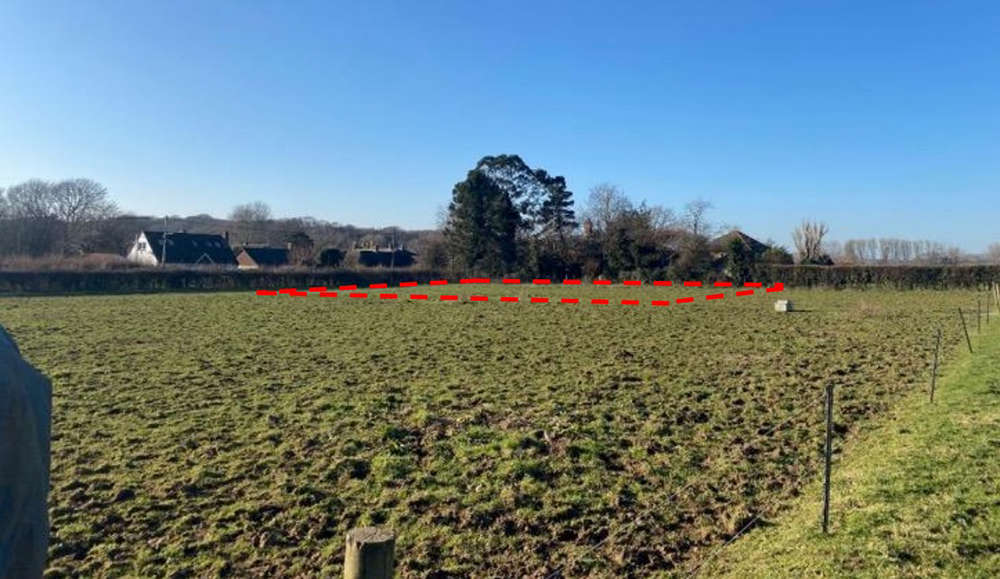This is not a drill. There is a chance - albeit a small one - that an asteroid could hit planet Earth within the next decade.
The 2024 YR4 asteroid set off automated asteroid warning systems after it was spotted through advanced telescopes in Rio Hurtado, Chile, last December.
Since then, the asteroid has jumped to the top of the risk list - a catalogue of all space objects which could possibly clash with our planet.
It's far from panic stations - but experts say the probability of an impact with Earth has almost doubled from 1.2% in January to about 2.3% now.
But how much do we know about the asteroid, and when will we know for sure if we're safe? Plus: what could happen if it really is heading our way?
When could it hit - and where?
If there is impact, it's estimated to be at 2.02pm on 22 December 2032 - though the precise time is prone to change, as is the exact probability of its collision with Earth.
NASA says the asteroid would likely hit somewhere across the eastern Pacific Ocean, northern South America, the Atlantic Ocean, Africa, the Arabian Sea, or South Asia.
What we know about the asteroid
2024 YR4 is estimated to be between 40m to 90m wide - or 130ft to 300ft.
It's made of a rocky substance rather than more robust materials like iron, which is significant because it means it could break into smaller pieces if it enters Earth's atmosphere, says Doctor Luca Conversi, who is the manager of the European Space Agency's (ESA) Near-Earth Object Coordination Centre (NEOCC), which is heavily involved in monitoring 2024 YR4.
The asteroid is currently at level three on the Torino Impact Hazard Scale, which is a system used to determine how big a threat an asteroid or comet is to planet Earth.
Level 3 is defined as a "close encounter meriting attention by astronomers", because it has a 1% or greater chance of collision capable of localised destruction.
The Torino Scale is the reason we know about the asteroid, because level 3 determines that the public and public officials should be notified when the encounter is less than a decade away.
For context: level 0 is when there is no chance or almost no chance of collision, and level 10 is reserved for when a collision capable of causing global catastrophe is certain.
Size matters - here's why
There is a big difference between an asteroid that's 40m wide or 90m wide - but experts aren't yet sure how big this one is.
Determining its rough size was important, because it is the size which reveals how big a threat we might be facing.
Earth is bombarded with more than 100 tons of dust and sand-sized particles every day, according to NASA - but they are small enough that they typically burn up in the atmosphere before they can cause any damage.
This means an asteroid or comet can have a 100% chance of reaching Earth but still be a 0 on the Torino Scale because its size doesn't pose a threat.
But 2024 YR4 is a level 3 threat because it is definitely larger than the 20m (65ft) threshold.
Its rough size has been estimated through the use of powerful telescopes, which are being used mainly to determine its orbit and whether it could be on course for Earth.
But those telescopes only allow astronomers to study the asteroid via the visible light it reflects from the sun.
The general rule is that the brighter an asteroid is, the larger it is, but it all depends on how reflective the asteroid is. 2024 YR4 could be 40m across and very reflective, or 90m across and not very reflective, the ESA says.
Without knowing its exact size, experts can't determine how significant the impact could be.
That's where NASA's powerful James Webb Space Telescope comes in.
The device, which has previously been used to capture unprecedented pictures of stars being born and dying, is now studying the asteroid using infrared light - or heat - which will lead to a better estimate of its size.
How much damage could it do?
If it does hit Earth, NASA says it would impact at a high velocity, roughly 17 kilometres per second - about 38,000mph.
"At about 40m it could be something that would be like an air blast - it might shatter some windows - wouldn't do too much damage," space journalist Kate Arkless Gray told presenter Wilfred Frost on Sky News Breakfast.
"If it was on the 90m end of the scale, we're looking at what they would call a city killer, where if it was to land on a major city - and there are a few in the potential hit zone - that would be disastrous."
What is happening now?
The asteroid is currently tens of millions of miles away from Earth, and is moving further away as it's set to go around the Sun.
It means scientists only have another few months to observe the asteroid until it disappears behind the Sun.
"We will be able to observe the asteroid until April," Dr Conversi tells Sky News.
"In the worst-case scenario, the probability can go as high as about 20%. But most likely, it will go to 0% by then," he adds.
So scientists will more likely than not rule out a collision with Earth by this April. If they can't, though, they will have to wait until the asteroid becomes visible again in 2028 to find out how likely it really is to head our way.
Behind the scenes there is collaboration between the likes of NASA and the ESA, which both have planetary defence offices, to gather as much information as possible before the asteroid disappears from view.
"It is really fascinating to see how the worldwide community is coming together in a unique and coordinated effort to understand as much as possible about this object in a very limited amount of time," says Dr Conversi.
There are still seven years between now and potential impact, but that time frame is a bit deceiving - because if scientists have not ruled out a collision by the time they lose sight of the asteroid in April, then they will have decisions to make before they can see it again in 2028.
What could be done about it?
It is only with more of a grasp on the orbit and size of the asteroid that scientists will start recommending action be taken - if it is needed.
If it is heading this way, one option is to launch a spacecraft to smash into the asteroid and change its trajectory - something NASA successfully did in 2022 to the 160m-wide asteroid Dimorphos.
It was called the Double Asteroid Redirection Test (DART), and was intended as a dress rehearsal should such an object ever threaten Earth.
It was a success in that it reached the asteroid and hit it, shifting its orbit by around 32 minutes - but another probe called HERA is on its way to that asteroid now to assess how successful the mission really was, and it isn't due to arrive until January next year.
Speaking to Kay Burley on Sky News, astronomer Dr David Whitehouse suggested scientists may need to take it a step further when it comes to 2024 YR4.
"We might even have to consider the severe measures of sending up a nuclear weapon to the surface of this asteroid in order to deflect it further," he said.
Prominent physicist Brian Cox has suggested that preparing to carry out a deflection mission is a good investment "even if we don't need to use it this time".
"It's as if the Universe has decided to do an experiment to see if Planet Earth is still capable of taking rational decisions," he wrote on X.
Dr Conversi says it is very plausible that experts will start "planning and actually building a mission" to deal with the asteroid while it is orbiting the Sun, before there is confirmation that it is heading towards Earth.
That's only if the risk isn't ruled out before April, when they'll lose sight of it.
The Space Mission Planning Advisory Group (SMPAG), chaired by the ESA, will be issuing a recommendation about further action to the United Nations Office for Outer Space Affairs should the threat not be ruled out by the time 2024 YR4 disappears from view.
Dr Conversi has told Sky News that launching something to smash into 2024 YR4 will only be considered if the asteroid is confirmed to be bigger than 50m.
He added launching such a mission would not be guaranteed success.
"There will also be some uncertainty: the launch could fail, or it might be that the asteroid would not be deviated from its orbit as we predicted," he said.
The alternative, he said, will be to take no "active" mitigation and instead let it hit Earth, evacuating the area it is set to hit.
"I always like to remind people that less than 5% of the Earth's surface is inhabited, so it is unlikely that the impact would occur in a populated area," he said when asked why this might be a viable option.
He also says that while allowing it to hit Earth is a possibility, "it'd be better to have no impact at all".
Should we actually be worried about 2024 YR4?
The likes of NASA and the ESA are continually playing down the threat level, insisting that there is still an "extremely low possibility" of impact, and that the asteroid can be dealt with effectively even if it is heading our way.
Astronomers such as Dr Whitehouse have voiced their concerns. He told Sky News the chances of the asteroid hitting Earth are "unacceptable to ignore" and means "we've got some very serious decisions to make".
He claimed it could turn out to be "the most dangerous thing in space" and added: "I can't stress strongly enough that this is a threat that's not a bit of astro fun, that it's not a bit of 'gosh, isn't it amazing?'
"This actually could turn out to be a serious threat to our planet."
Read more:
Scientists spot rare ring of light from far-away galaxy
The new space race to the moon heats up
But Dr Conversi, when asked how the scientists behind the scenes are feeling, says there is a sense of "hype" because this is a rare event that allows them to "exercise all our systems and knowledge on a real case".
"Yet, the impact probability is low... so we aren't worried nor in any life-threatening scenarios," he adds.
He says he tells his family and friends that "we are not worried, quite the opposite: we know that, in all likelihood, the impact will not occur".
He adds: "I also try to transmit the excitement this object is causing in the community and explain all the steps we have taken - and are taking."
Has this happened before?
It's very rare that an asteroid of this size has such a high probability of colliding with Earth.
Comparisons have been drawn between the 2024 YR4 and the Apophis asteroid, discovered in 2004, which was briefly estimated to have a 2.7% chance of impacting Earth in 2029.
But that impact probability dropped to nearly 0% within a couple of days. It was the extreme size of the Apophis - 300m - which drew the most attention to it.
Earth does take direct hits from asteroids of a similar size to 2024 YR4, but only once every few thousand years.
In 1908, a slightly smaller asteroid - thought to have measured 60m across - exploded over Siberia. The incident, which became known as the Tunguska Event, saw 80 million trees flattened over a remote area spanning 830 square miles.
Local eyewitnesses in the sparsely populated region reported seeing a fireball and hearing a large explosion, according to NASA, but no one was harmed.
Asteroids are ancient space rocks left over from the formation of the Solar System which are thought to have brought complex molecules, and possibly early life, to Earth billions of years ago.

(c) Sky News 2025: 2024 YR4: What we know about the asteroid that could hit Earth


 Ukraine still on 'irreversible path to joining NATO' Starmer tells Zelenskyy
Ukraine still on 'irreversible path to joining NATO' Starmer tells Zelenskyy
 Horror, unease and questions for US allies as Trump's big shift puts European security in doubt
Horror, unease and questions for US allies as Trump's big shift puts European security in doubt
 Risk of rising US prices could be biggest brake on Donald Trump's tariff plan
Risk of rising US prices could be biggest brake on Donald Trump's tariff plan
 Anora to Wicked: Award-tipped films you need to know about and where to watch them
Anora to Wicked: Award-tipped films you need to know about and where to watch them
 Baby formula prices and branding leading to 'poor outcomes' for parents, watchdog says
Baby formula prices and branding leading to 'poor outcomes' for parents, watchdog says



 Upgrades Planned For Major Island Caravan Site
Upgrades Planned For Major Island Caravan Site
 Planners Approve Alverstone Bungalow Despite Objections From Residents
Planners Approve Alverstone Bungalow Despite Objections From Residents
 New Vote Of Confidence For Island Services In Healthwatch Report
New Vote Of Confidence For Island Services In Healthwatch Report
 Finance Reserve Row Breaks Out Between County Hall Groups
Finance Reserve Row Breaks Out Between County Hall Groups